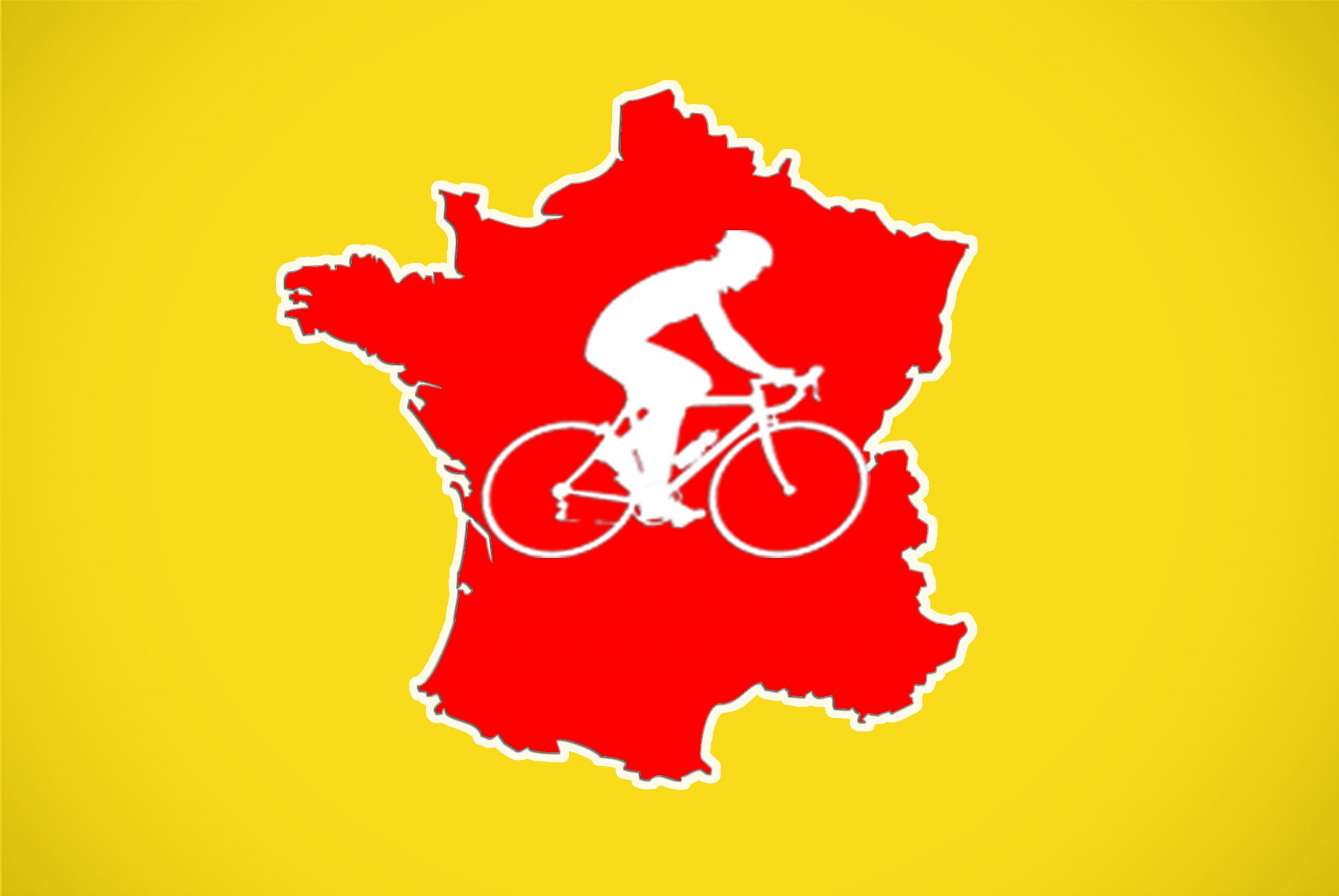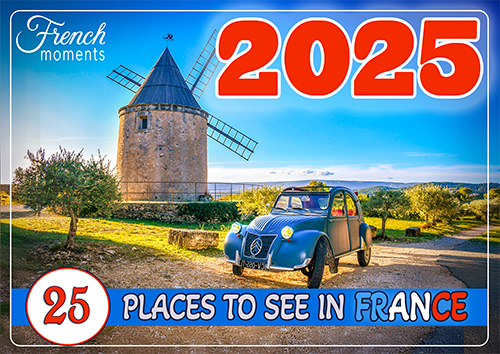The Tour de France is the world’s most iconic cycling race — a legendary sporting event that transforms the month of July into a national celebration across France.
First organised in 1903, the Tour has grown into a grand spectacle of athleticism, strategy, drama, and endurance, watched by millions both at the roadside and on screens around the globe.
Every summer, the race winds its way through stunning French landscapes: from Alpine mountain passes to rolling vineyards, sun-drenched villages to windswept coastlines.
And wherever the riders go, the country follows. Roadsides fill with spectators waving flags and ringing cowbells, cheering on their heroes with a passion that’s uniquely French.
It’s not just a bike race — it’s a travelling festival, a test of human limits, and a national tradition steeped in history.
For the French, the Tour de France isn’t merely a sporting event; it’s a rhythm of life, a moment of unity, and a display of grit and glory.
The ‘Grande Boucle’, as it’s affectionately known, captures the imagination like few other events in the world.
Let’s find out more!
A bit of history

The Tour de France was born in 1903, the brainchild of sports journalist Géo Lefèvre and Henri Desgrange, editor of the newspaper L’Auto.
Their goal? To boost sales by creating an unprecedented endurance race that would capture the imagination of the French public — and it worked.
That very first edition, with just six stages, laid the foundations for what would become the most prestigious cycling event in the world.
But make no mistake — those early Tours were brutal.
Riders faced daily stages of up to 400 kilometres, often pedalling through the night on rough, unpaved roads.
There were no support teams, no radio communication, and certainly no luxurious recovery buses.
Cyclists had to be their own mechanics, carrying tools and spare parts with them in case of breakdowns.
If something went wrong, they had to fix it themselves — or walk.
Despite the hardship, or perhaps because of it, the Tour quickly became a symbol of resilience and heroism.
Over the years, it evolved, introducing shorter stages, mountain climbs, team tactics and the now-famous yellow jersey (maillot jaune) — awarded to the rider with the lowest overall time.
The maillot jaune first appeared in 1919, its colour chosen to match the pages of L’Auto.
The race was paused during the First and Second World Wars, but otherwise, it has run every single year, crossing the varied terrain of France — and occasionally venturing into neighbouring countries.
Over time, it inspired similar events such as the Giro d’Italia and the Vuelta a España, yet the Tour has always remained the benchmark of professional road cycling.
Today, it is organised by the Amaury Sport Organisation. (ASO) and broadcast to a worldwide audience of millions.
For towns and cities across France, hosting a stage start or finish is a major event — it brings prestige, media attention, and a welcome boost to the local economy.
Roads are freshly repaved, shop windows decorated, and entire communities turn out in celebration, as the caravan rolls into town.
Format of the Tour de France
While the original Tour de France followed a continuous loop around the perimeter of France, the modern format is a bit more creative — and logistically complex.
These days, the race is broken up into 21 daily stages spread over 23 days, with two well-earned rest days in between.
The route changes every year, but it always offers a balanced mix of flat sprints, hilly terrain, mountain climbs, and time trials.
And although the course no longer traces a perfect circle around the country, it still manages to showcase the incredible variety of France’s geography.
Each edition of the Tour covers roughly 3,300 to 3,600 kilometres (around 2,200 miles), depending on the route.
Stages can last anywhere from a few hours to over five and a half, and on long days, riders may cover up to 225 kilometres in the saddle.
From windswept plains to gruelling Alpine switchbacks, every stage brings its own tactical challenges — and potential for surprise.
The Advertising Caravan
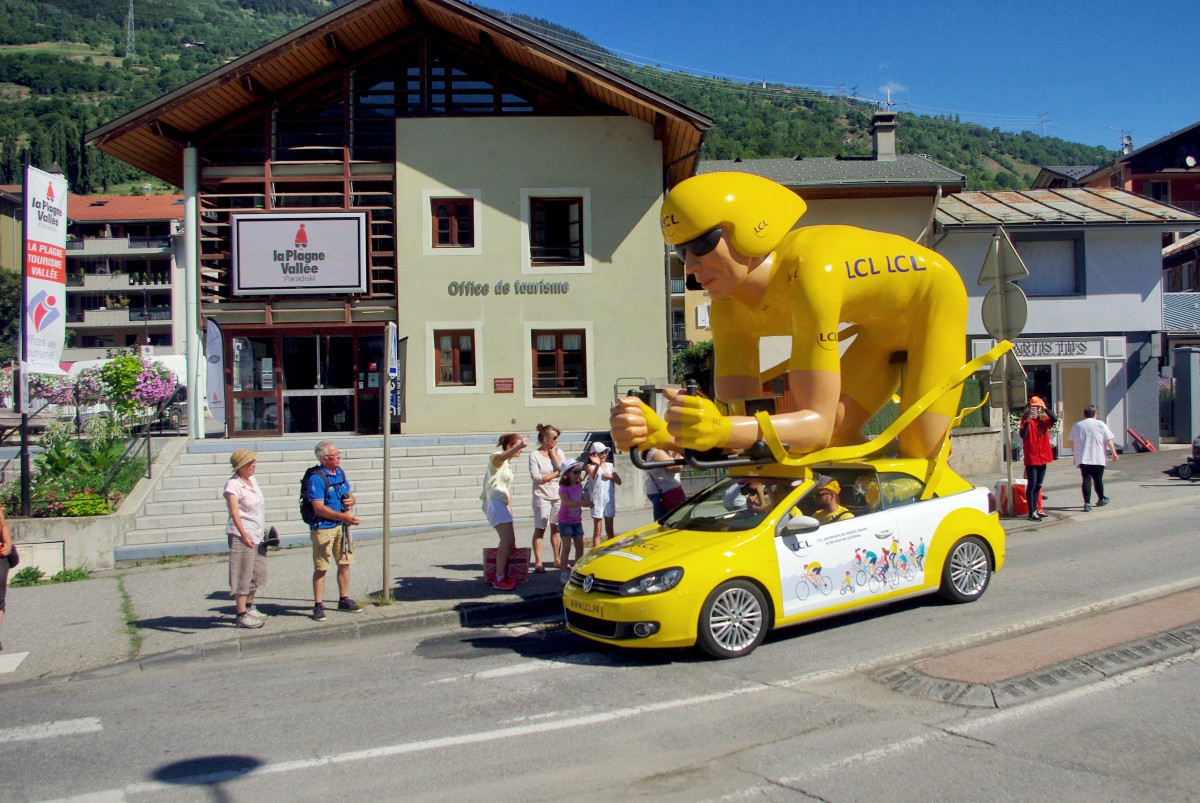
Before the peloton even arrives, the atmosphere along the roadside is already electric.
That’s thanks to the advertising caravan, a joyful and slightly surreal convoy of brightly decorated vehicles that rolls along the route about 90 minutes ahead of the riders.
Introduced in 1930, the caravan was originally designed to help fund the race independently of individual teams, and it quickly became a beloved part of the spectacle.
Today, it’s a full-on mobile carnival: over 150 vehicles, each representing a different brand, tossing freebies — hats, keychains, sausages, candy, cheese, fridge magnets… you name it — into the crowd.
Children scramble to collect the best goodies, while adults cheer, laugh, and wave at the performers onboard.
For many spectators, the caravan is just as much a highlight as the race itself.
Types of Stages
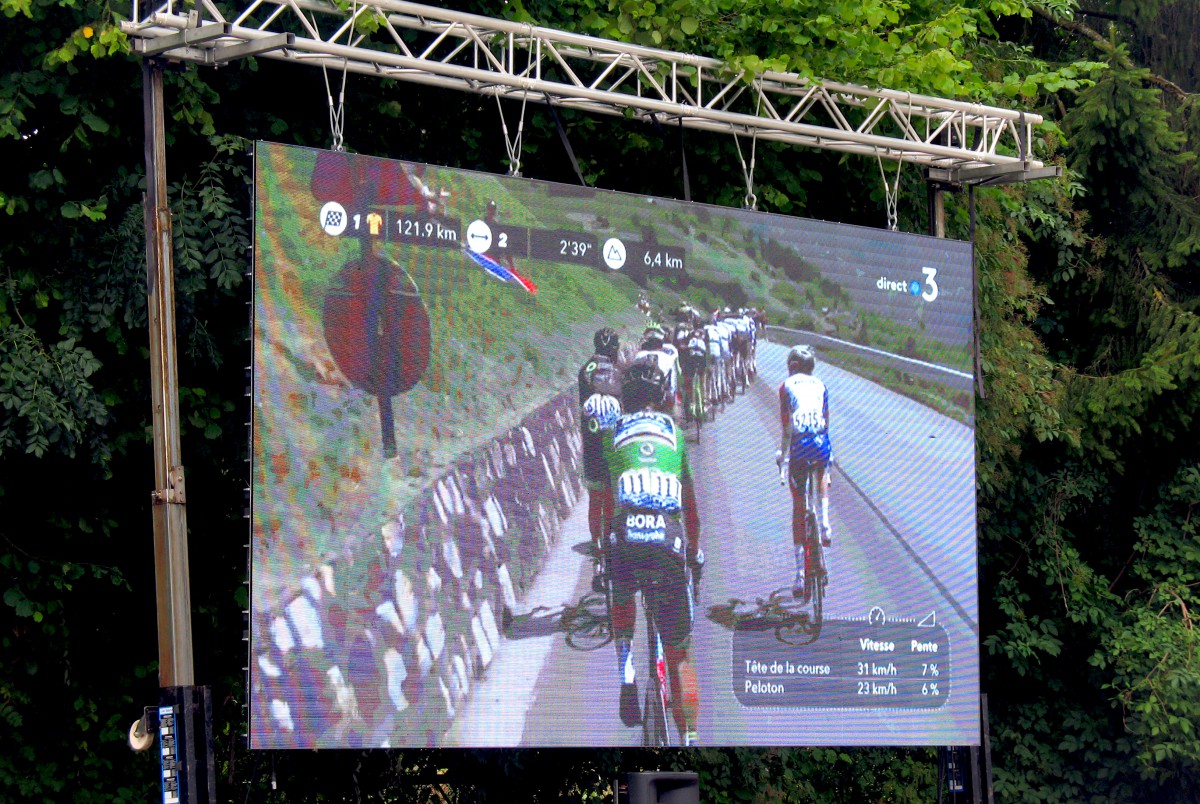
Not all stages in the Tour de France are created equal.
The variety is what makes the race so tactically complex — and thrilling to watch.
There are three main types of stages:
Mass-start stages: These are the most common. All riders start together in a festive atmosphere, often from a picturesque town square. The real start (départ réel) happens a few kilometres later, when the race director lowers the white flag — and then, the real racing begins.
Individual time trials (contre-la-montre individuel): In these stages, riders set off one by one at regular intervals, racing against the clock. There’s no hiding in a peloton here — it’s pure effort, strategy, and pacing. Time trials are often decisive for the general classification.
Team time trials (contre-la-montre par équipe): Less frequent but highly strategic, these stages see each team ride together in a tightly organised formation. The team’s time is usually taken on the fifth rider to cross the line, so teamwork and coordination are key.
In mountain stages, you’ll also hear about HC climbs (hors catégorie), meaning “beyond categorisation” — the toughest climbs of the race, often where legends are made (or broken).
The winner’s goal
![Tour de France 2013 at Aix-en-Provence © Georges Seguin - licence [CC BY-SA 3.0] from Wikimedia Commons](https://frenchmoments.eu/wp-content/uploads/2014/05/Tour-de-France-2013-at-Aix-en-Provence-©-Georges-Seguin-licence-CC-BY-SA-3.0-from-Wikimedia-Commons.jpg)
The ultimate objective of the Tour de France is simple in theory: to complete the race in the lowest cumulative time.
But achieving that requires not just speed, but consistency, endurance, strategy, and sometimes a bit of luck.
Crashes, mechanical issues, or even a poorly timed gust of wind can derail a contender’s hopes.
The rider who leads the overall classification after each stage wears the iconic yellow jersey (maillot jaune).
First introduced in 1919, the jersey’s bright colour matched the yellow pages of L’Auto, the newspaper that founded the race.
The very first cyclist to wear it was Eugène Christophe.
Over the years, legends have emerged.
Eddy Merckx, widely considered the greatest cyclist of all time, wore the yellow jersey for a record 96 stages — a record that still stands.
Other jerseys include:
Green jersey (maillot vert): best sprinter
Polka-dot jersey (maillot à pois): best climber
White jersey (maillot blanc): best young rider under 26
But make no mistake: the yellow jersey is the holy grail of cycling.
Broadcasting the Tour de France
![Mont Saint Michel Tour de France © Jejecam - licence [CC BY-SA 3.0] from Wikimedia Commons](https://frenchmoments.eu/wp-content/uploads/2014/05/Mont-Saint-Michel-Tour-de-France-©-Jejecam-licence-CC-BY-SA-3.0-from-Wikimedia-Commons.jpg)
Covering a race that moves across a country at 40 km/h is no easy feat.
Yet France Télévisions manages the task with military precision, providing the live footage used by broadcasters around the world.
It takes an army of 300 crew members, including four helicopters, two aircraft, camera-equipped motorbikes, and dozens of vehicles to track the action from every angle — including breathtaking aerial shots of castles, mountains, and vineyards.
The Tour is now broadcast in over 190 countries, reaching a global audience of nearly 3.5 billion viewers over three weeks.
It’s one of the most watched annual sporting events in the world — and an unrivalled showcase for French tourism.
Viewing the Tour
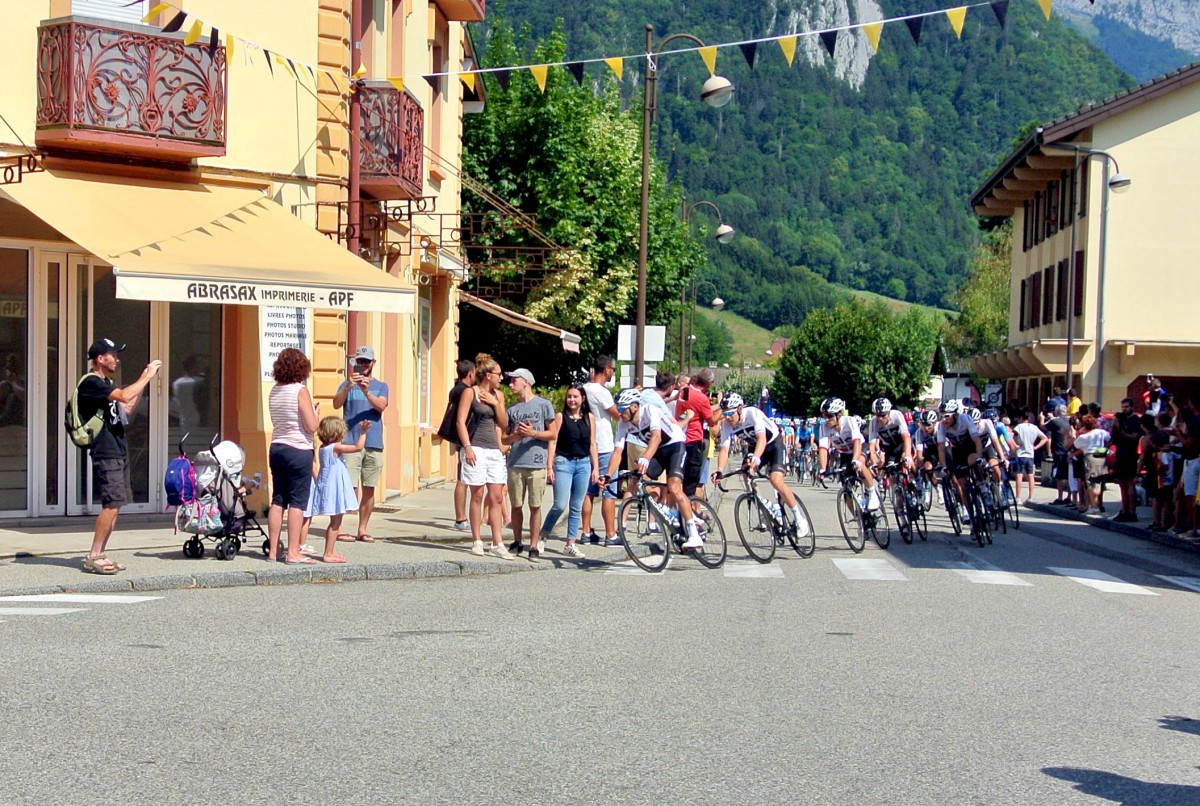
One of the best things about the Tour de France?
It’s completely free to watch.
No ticket required. You simply pick your spot along the route, settle in, and wait for the spectacle to arrive.
Some of the most dedicated fans camp out for days — even a week — in the mountains to claim a prime viewing spot.
Families bring folding chairs, picnic blankets, baguettes, cheese, and bottles of wine.
Transistor radios or smartphones keep them updated on the riders’ progress.
As the caravan passes and the helicopters buzz overhead, excitement builds.
And when the peloton finally flashes past in a blur of colour and speed, it’s a moment of pure magic.
The mood is often festive and welcoming — people chat with strangers, share food, and enjoy a unique mix of tension and joy.
Whether you’re in a sleepy village or on a hairpin bend in the Alps, watching the Tour de France from the roadside is a truly unforgettable experience.
The Tour de France Jerseys
![Pierre Rolland at Tour de France 2013 © Marianne Casamance - licence [CC BY-SA 3.0] from Wikimedia Commons](https://frenchmoments.eu/wp-content/uploads/2014/05/Pierre-Rolland-at-Tour-de-France-2013-©-Marianne-Casamance-licence-CC-BY-SA-3.0-from-Wikimedia-Commons.jpg)
Beyond the thrills of each stage and the drama of the mountain climbs, the Tour de France is also a race within the race.
Every day, riders compete not only for stage victories but also for one of the four iconic jerseys that reward excellence in different categories.
Each jersey tells its own story — of speed, stamina, strategy, and promise.
🟡 The Yellow Jersey (Maillot Jaune):
This is the most prestigious of them all — the holy grail of professional cycling. It’s worn by the overall race leader, the rider with the lowest cumulative time since the start of the Tour. First introduced in 1919 by the newspaper L’Auto, the jersey’s yellow colour matched the paper on which the race was first reported. It’s a symbol of dominance, consistency, and tactical intelligence. Wearing it is an honour. Keeping it to Paris? Legendary.🟢 The Green Jersey (Maillot Vert):
Awarded to the best sprinter, this jersey rewards consistency in intermediate sprints and stage finishes, especially on flat terrain. Points are given based on finishing positions, and the rider with the most points wears green. It’s not uncommon for this jersey to change shoulders multiple times throughout the Tour, particularly in the early stages. Expect to see it on the back of fast-twitch, fearless riders who thrive in chaotic bunch sprints.🔴⚪ The Polka-Dot Jersey (Maillot à Pois Rouges):
Instantly recognisable thanks to its red dots, this jersey is awarded to the so-called “King of the Mountains” — the rider who earns the most points by reaching the summits of categorised climbs before anyone else. Each climb is graded based on its difficulty, and the toughest — the hors catégorie — offers the most points. Winning this jersey means you’re among the most fearless climbers in the peloton, attacking steep inclines with strength and elegance.⚪ The White Jersey (Maillot Blanc):
This one celebrates youth and future talent. It’s awarded to the best young rider under 25 in the overall classification. Many former white jersey winners have gone on to win yellow later in their careers — making it a strong predictor of greatness to come. If you want to spot the next generation of Tour legends, keep your eye on this jersey.
Each morning, these jerseys are worn with pride — but also with pressure.
They’re not just colourful shirts; they’re targets, ambitions, and symbols of triumph in one of the most demanding races on Earth.
Traditions of the Tour de France
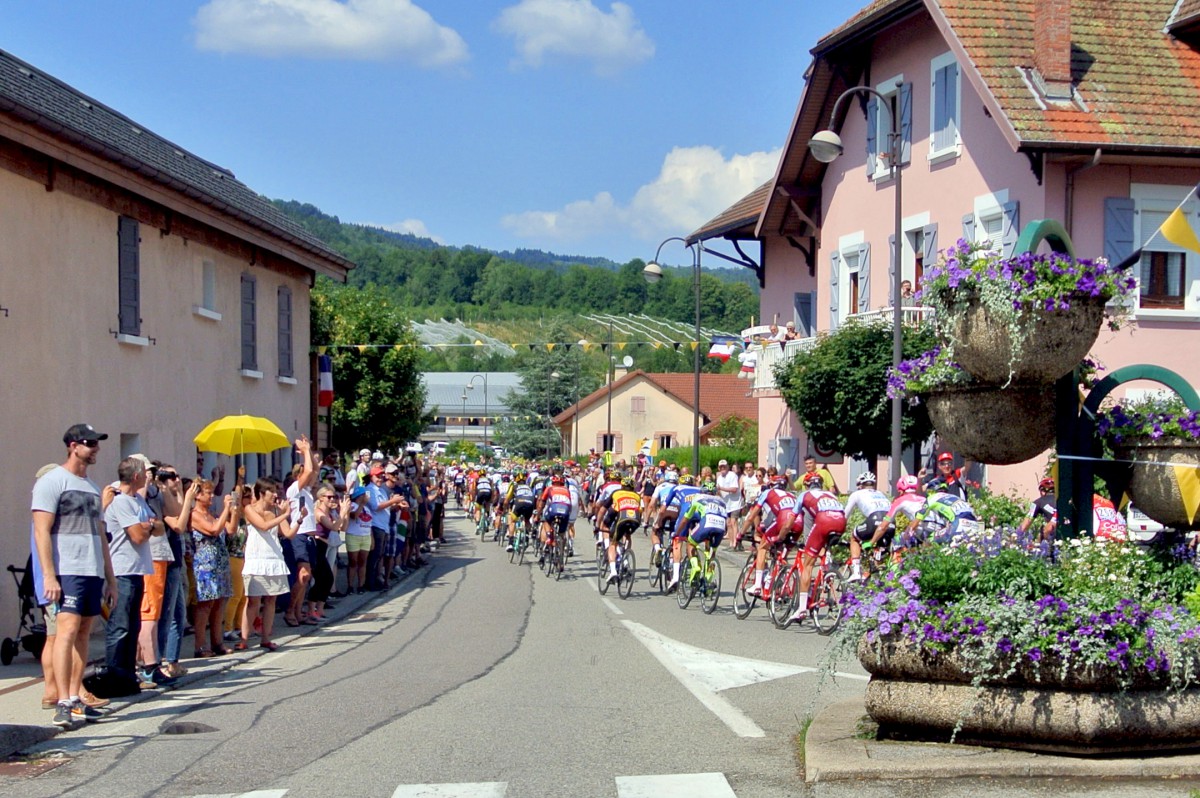
More than just a race, the Tour de France is steeped in ritual.
Over its long history, a number of traditions have emerged — some official, others more symbolic — and they form the backbone of what makes the Tour so beloved by fans around the world.
🗓 It takes place every July
Since the early 20th century (with breaks only during the two World Wars), the Tour has become a fixed point in the summer calendar. For three weeks in July, France becomes the stage for one of the world’s most dramatic sporting journeys. The race typically lasts 23 days, including 21 stages and two rest days.🚛 The advertising caravan opens the show
A quintessential part of the Tour since 1930, the caravane publicitaire precedes the riders each day by about 90 minutes. With loud music, confetti, honking horns and dozens of colourfully branded vehicles, it creates a festive, carnival-like atmosphere. Brands throw freebies — everything from sweets and sausage to baseball caps and keyrings — to the waiting crowds. For kids (and not just kids!), it’s a highlight of the day.🏔 Iconic climbs in the Alps and Pyrenees
The Tour’s route changes every year, but certain elements are so iconic that they appear again and again. Chief among them: the mountain stages. Riders tackle brutal ascents in both the Alps and the Pyrenees, often in back-to-back days. Legendary climbs include:L’Alpe d’Huez with its famous 21 hairpin bends
The unforgiving Mont Ventoux, a bald, windswept giant nicknamed the “Beast of Provence”
The historic Col du Tourmalet, the most visited pass in Tour history
The breathtaking Col du Galibier, often the highest point of the race
These mountains are where heroes are made — or broken. For fans, they’re the heart and soul of the Tour.
🌍 International starts and detours
While the Tour is undeniably French, it’s not confined to France’s borders. Over the decades, the race has regularly started or passed through neighbouring countries, including Belgium, Spain, Italy, Switzerland, Germany, and even England. These international stages highlight the race’s global appeal and allow fans from other countries to experience the magic up close.🏁 The grand finale on the Champs-Élysées
Since 1975, the Tour de France has traditionally ended in Paris, with a spectacular finish on the Avenue des Champs-Élysées. Riders do several laps up and down the most famous avenue in the world, past cheering crowds and historic landmarks. It’s a moment of celebration, elegance — and sometimes, a final high-speed sprint.In 2024, however, there was a rare break from tradition. Due to the Paris Summer Olympics, the Tour concluded in Nice, offering a Mediterranean twist to the final stage.
🦁 The podium ritual
At the end of each stage, winners step onto the podium to receive their rewards. The yellow jersey wearer is presented with a bouquet of flowers — and a plush lion. Why a lion? It’s a nod to the Tour’s long-time sponsor, Le Crédit Lyonnais (from Lyon, the city… and lion, the animal!). This fuzzy mascot has become an endearing symbol of the race, especially among young fans.
These traditions — big and small — are part of what makes the Tour de France more than a sporting event.
They give it rhythm, charm, and a deeply rooted connection to French culture and everyday life.
Whether you’re watching it for the first time or the fiftieth, the Tour never quite loses its appeal.
Unwritten Rules and Quirky Traditions
Beyond the official jerseys, the podium lions, and the iconic mountain climbs, the Tour de France is rich in unwritten rules and quirky customs that have become part of its unique charm — the kind of traditions you won’t find in the rulebook, but that everyone in the cycling world understands and respects.
🥂 Champagne on the final stage
The last day of the Tour is more a celebration than a competition — at least until the final sprint. For most of the stage, especially for the general classification leader in yellow, it’s a relaxed ride into Paris (or, in 2024, into Nice). The peloton chats, laughs, and toasts with glasses or bottles of champagne handed out by the support cars. It’s a symbolic gesture — the hard work is done, and the victor can finally enjoy the ride.🎒 Feed zones and musettes
During longer stages, riders receive food and drink from their team in special “musettes” — small cloth shoulder bags handed to them on the move. Each team has soigneurs (helpers) stationed at designated feed zones, who hand over musettes filled with energy gels, sandwiches, rice cakes, and water bottles. Catching the bag smoothly is a skill in itself — drop it, and you might go hungry until the next climb.🚴 Waiting for fallen leaders
In the spirit of sportsmanship, it’s traditional for the peloton to wait if the yellow jersey crashes or has a mechanical problem, especially in the early part of a stage. Attacking while the race leader is down is generally frowned upon — unless, of course, the race is entering its final moments or a mountain battle is underway.👕 Fans in costume
Along the roadside, especially in the mountains, costumed fans have become a Tour tradition of their own. You’ll see people dressed as devils, bananas, cows, superheroes, or even full historical reenactments. Some have become local legends, like “El Diablo” — a German fan dressed as a red devil who chased riders up the Alps for decades.🎨 Painted roads and names
Supporters often paint the names of their favourite cyclists directly onto the tarmac — particularly on the steepest climbs. Slogans like “Allez Thibaut!”, “Go Pogacar!”, or “Vive Pinot!” appear in bright white paint, cheering riders as they pass. These messages may fade over time, but for one glorious day, they’re part of the race itself.🚫 No toilet talk… but yes, nature breaks
It’s not often mentioned, but in a race that lasts five or six hours a day, nature calls. At certain moments — usually early in a stage — a truce is silently agreed upon. Riders pull over en masse for a “pause technique”, stretch their legs, and relieve themselves discreetly. The peloton slows down, and no one attacks. It’s one of those unglamorous yet strangely human details of professional cycling.
All these elements — the formal and the informal, the grand traditions and the cheeky habits — come together to make the Tour de France not just a competition, but a rolling festival of sport, culture, and camaraderie.
It’s a race of legends, yes — but also of rituals, rhythms, and countless human stories unfolding along the way.
The Winners of the Tour de France
![Cadel Evans 5th stage of Tour de France 2011 © Thortuck - licence [CC BY-SA 3.0] from Wikimedia Commons](https://frenchmoments.eu/wp-content/uploads/2014/05/Cadel-Evans-5th-stage-of-Tour-de-France-2011-©-Thortuck-licence-CC-BY-SA-3.0-from-Wikimedia-Commons.jpg)
Over the decades, the Tour de France has crowned some of the greatest legends in cycling history.
Winning the Tour once is a career-defining achievement. Winning it multiple times places a rider among the all-time greats.
Here’s a look at some of the most notable winners:
🏆 Recent Winners
2024: Tadej Pogačar (Slovenia) – his third overall win
2023: Jonas Vingegaard (Denmark) – second consecutive win
2022: Jonas Vingegaard (Denmark) – first win
2021: Tadej Pogačar (Slovenia) – second win
2020: Tadej Pogačar (Slovenia) – first win
2019: Egan Bernal (Colombia) – first Colombian to win the Tour
2018: Geraint Thomas (United Kingdom) – first and only win
2017, 2016, 2015, 2013: Chris Froome (United Kingdom) – four-time winner
Note: Froome also finished 2nd in 2012, but was later declared the winner after Bradley Wiggins’ victory was reassessed in the context of team strategy.
❌ The Lance Armstrong Era (1999–2005)
Between 1999 and 2005, American cyclist Lance Armstrong crossed the finish line in Paris as the winner seven times in a row, a feat unmatched in Tour history. However, in October 2012, the Union Cycliste Internationale (UCI) stripped him of all titles after revelations of systematic doping. These seven editions now officially have no winner.
🥇 Multiple Winners of the Tour de France
Only a handful of riders have dominated the Tour de France across multiple years. Here are the legends who won the race three times or more:
🚴♂️ Five-time winners:
Jacques Anquetil (France): 1957, 1961, 1962, 1963, 1964
Eddy Merckx (Belgium): 1969, 1970, 1971, 1972, 1974
Bernard Hinault (France): 1978, 1979, 1981, 1982, 1985
Miguel Indurain (Spain): 1991, 1992, 1993, 1994, 1995
Indurain holds the unique record of winning five Tours in a row.
🏅 Four-time winner:
Chris Froome (United Kingdom): 2013, 2015, 2016, 2017
🏅 Three-time winners:
Philippe Thys (Belgium): 1913, 1914, 1920
The first rider to win the Tour three times.
Louison Bobet (France): 1953, 1954, 1955
Greg LeMond (United States): 1986, 1989, 1990
Famously won in 1989 by just 8 seconds — the narrowest margin in Tour history.
Tadej Pogačar (Slovenia): 2020, 2021, 2024
Still active — and widely expected to aim for a fourth win.
Whether it’s the icy calm of Indurain, the raw power of Merckx, or the youthful brilliance of Pogačar, these riders have all etched their names into the epic story of the Tour de France — a race where glory is earned the hard way, one kilometre at a time.
Editions of the Tour de France
Each year, the Tour de France reinvents itself.
While the core traditions remain — 21 stages, three weeks of racing, and a finish in July — the route changes every year, offering new challenges for the riders and fresh discoveries for the spectators.
Some years highlight mountain showdowns, others favour the sprinters, and occasionally the organisers throw in cobblestones, gravel roads or foreign detours just to shake things up.
Let’s take a closer look at some of the most notable editions from recent years:
2025 – A Grand Tour All Across France
The 112th edition of the Tour de France takes place from 5 to 27 July 2025 and marks a return to a fully French route — a rarity in recent years.
This year’s race starts in Lille, in the Hauts-de-France region, and ends with the traditional finish on the Champs-Élysées in Paris.
For the first time, the final stage includes a triple ascent of Montmartre, adding a touch of drama and Parisian flair.
The 2025 route stretches over 3,338.8 km, with a positive elevation gain of over 51,000 metres.
Riders will cross 11 of France’s 13 metropolitan regions, including the Alps, Pyrenees, Massif Central, Brittany, Normandy, and the Loire Valley.
In total, 34 départements are visited, and 8 towns welcome the Tour for the first time as stage hosts — including Lauwin-Planque, Chinon, Le Mont-Dore – Puy de Sancy, and Vif.
![Tour de France 2025. Image by andrei Ioas - licence [CC BY 4.0] from Wikimedia Commons](https://frenchmoments.eu/wp-content/uploads/2014/05/Tour-de-France-2025.-Image-by-andrei-Ioas-licence-CC-BY-4.0-from-Wikimedia-Commons.jpg)
2024 – The 111th Edition: Florence to Nice
A year unlike any other. With the Paris Summer Olympics taking place shortly after the race, the 2024 edition broke with tradition in two major ways:
The Grand Départ was held in Florence, Italy, marking the 100th anniversary of Ottavio Bottecchia’s historic win — the first Italian to win the Tour in 1924.
For the first time in history, the Tour did not finish in Paris. Instead, the final stage took place in Nice, on the Mediterranean coast — a sun-soaked alternative to the Champs-Élysées.
The race ran from 29 June to 21 July 2024, featuring high mountain drama in both the Alps and Pyrenees, as well as a time trial finale on the final day — something not seen since 1989.
![Tour de France 2024 by Andrei loas - licence [CC BY 4.0] from Wikimedia Commons](https://frenchmoments.eu/wp-content/uploads/2014/05/Tour-de-France-2024-by-Andrei-loas-licence-CC-BY-4.0-from-Wikimedia-Commons.jpg)
2023 – Return to the Puy de Dôme
The 110th edition of the Tour de France brought back a legendary climb: the Puy de Dôme, not used since 1988.
The race began in Bilbao, in the Basque Country of Spain, on 1 July — the second time the Grand Départ had taken place there.
Riders faced intense stages in the Pyrenees, the Jura, and the Alps, including a dramatic finish on the Col de la Loze at over 2,300 metres.
After three weeks of high-altitude battles, Jonas Vingegaard (Denmark) retained his title, winning his second consecutive Tour de France.
The final stage returned to its traditional finish on the Champs-Élysées in Paris.
![Tour de France 2023. Image by Andrei Loas - licence [CC BY-SA 4.0] from Wikimedia Commons](https://frenchmoments.eu/wp-content/uploads/2014/05/Tour-de-France-2023.-Image-by-Andrei-Loas-licence-CC-BY-SA-4.0-from-Wikimedia-Commons.jpg)
2022 – Danish Start, Alpine Drama
The 109th edition started in Copenhagen, Denmark — the northernmost Grand Départ in the history of the Tour.
The first three stages were held in Denmark, before the race returned to France for a thrilling sequence through northern cobblestone roads, the Massif Central, the Alps, and the Pyrenees.
It was a head-to-head battle between defending champion Tadej Pogačar and rising star Jonas Vingegaard.
The Danish rider ultimately triumphed, delivering a historic first Tour win for Denmark.
Vingegaard’s dominant performance in the Alps, particularly on Col du Granon, proved decisive.
![Tour de France 2022. Image by Andrei Loas - licence [CC BY-SA 4.0] from Wikimedia Commons](https://frenchmoments.eu/wp-content/uploads/2014/05/Tour-de-France-2022.-Image-by-Andrei-Loas-licence-CC-BY-SA-4.0-from-Wikimedia-Commons.jpg)
2021 – Double Triumph for Pogačar
In its 108th edition, the Tour returned to Brittany for the Grand Départ, starting in Brest.
The race featured classic French landscapes: rugged Atlantic coastlines, the Massif Central, and the mighty Alps and Pyrenees.
Slovenian prodigy Tadej Pogačar dominated the race, showing remarkable strength in both time trials and mountain stages.
He wore the yellow, polka-dot, and white jerseys — a rare feat — and claimed his second Tour victory in as many years.
Once again, the Tour finished on the Champs-Élysées.
![Tour de France 2021. Image by Andrei Loas - licence [CC BY-SA 4.0] from Wikimedia Commons](https://frenchmoments.eu/wp-content/uploads/2014/05/Tour-de-France-2021.-Image-by-Andrei-Loas-licence-CC-BY-SA-4.0-from-Wikimedia-Commons.jpg)
2020 – A Tour in the Time of Covid
The 107th edition was like no other.
Originally scheduled for July, the race was postponed to 29 August–20 September 2020 due to the COVID-19 pandemic — the first time the Tour had ever taken place in late summer.
Despite the challenges, the race delivered one of the most thrilling finales in modern history.
Tadej Pogačar, just 21 years old, snatched victory from compatriot Primož Roglič in a dramatic individual time trial on stage 20.
It was Slovenia’s first Tour win — and one for the history books.
The final stage followed tradition, concluding in Paris on a sunny September day.
![Tour de France 2020. Image by Andrei Loas - licence [CC BY-SA 4.0] from Wikimedia Commons](https://frenchmoments.eu/wp-content/uploads/2014/05/Tour-de-France-2020.-Image-by-Andrei-Loas-licence-CC-BY-SA-4.0-from-Wikimedia-Commons.jpg)
2019 – Route of the 106th edition
The 106th edition began in Brussels, paying tribute to Eddy Merckx, 50 years after his first Tour victory.
The route then crisscrossed eastern France, with stages in Champagne, Lorraine, Alsace, Burgundy, Franche-Comté, and the Alps, before heading to the Massif Central, the Pyrenees, and back towards Paris.
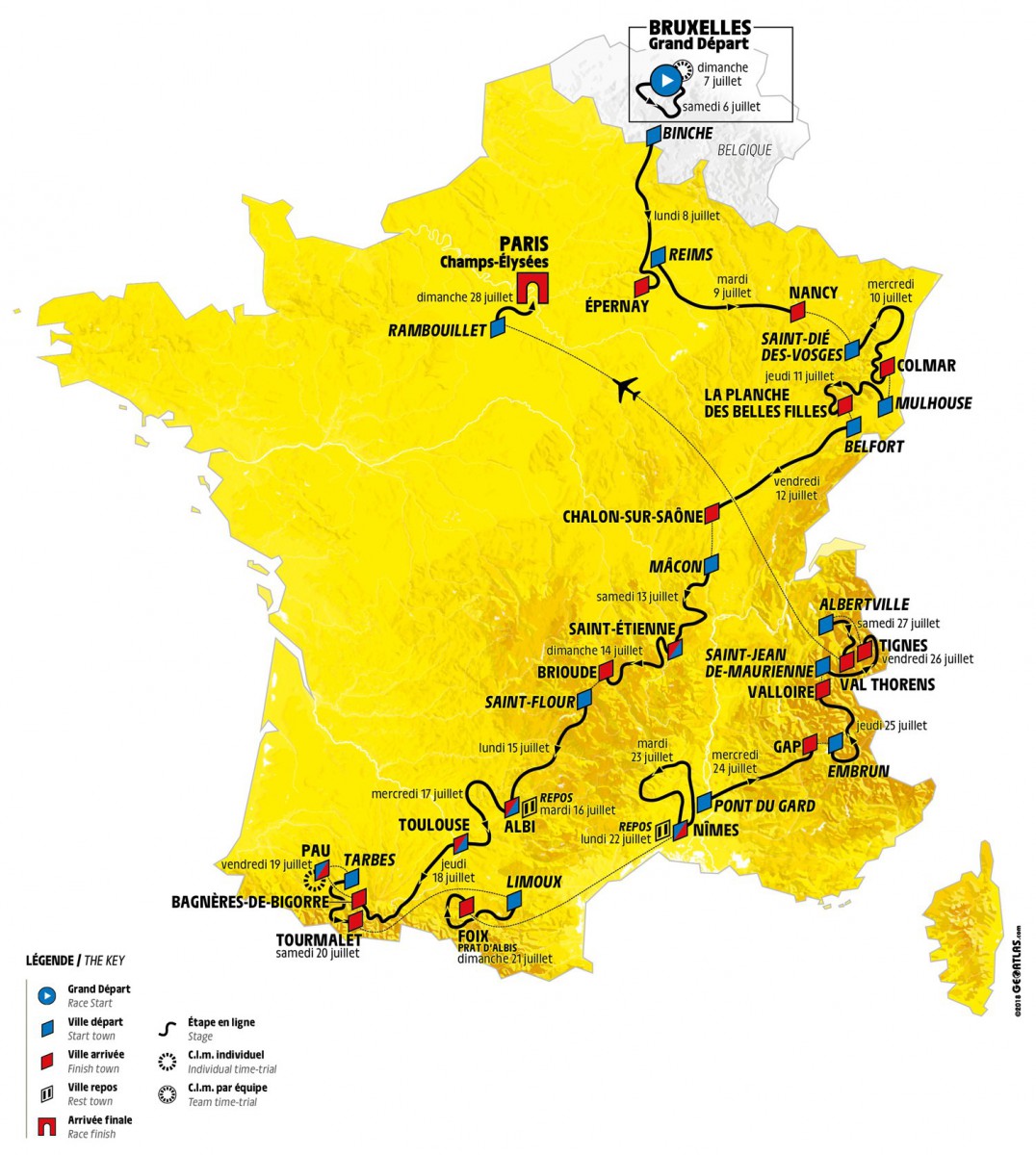
2018 – Route of the 105th edition
The 105th edition of the Tour stayed entirely within French borders — a rare occurrence in modern Tours.
Riders tackled stages across Brittany, the Hauts-de-France, the Alps, the Massif Central, and the Pyrenees, with the legendary Alpe d’Huez making its appearance once again.
The final stage started in Houilles (Yvelines) and ended, as tradition dictates, on the Champs-Élysées.
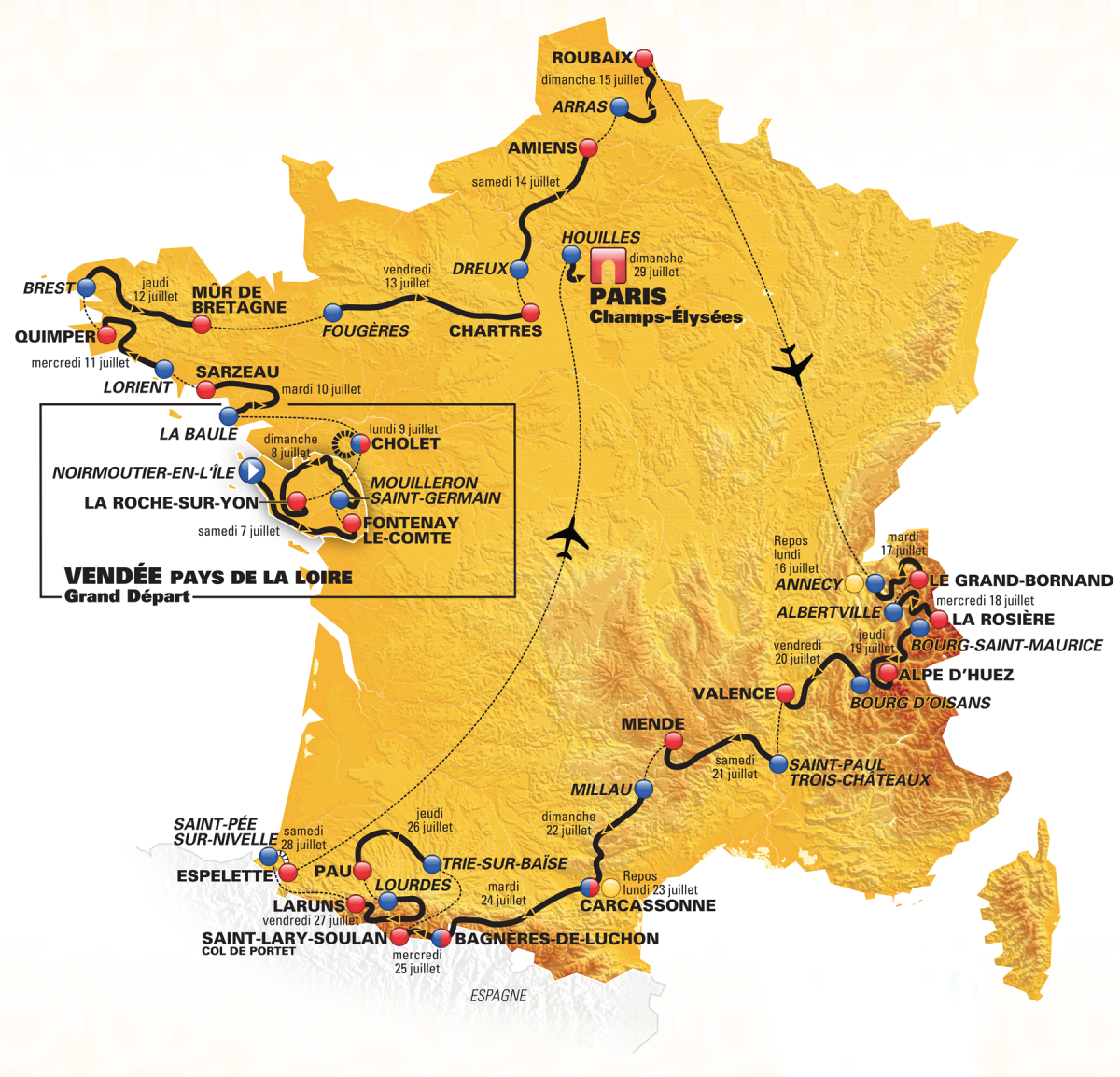
2017 – Route of the 104th edition
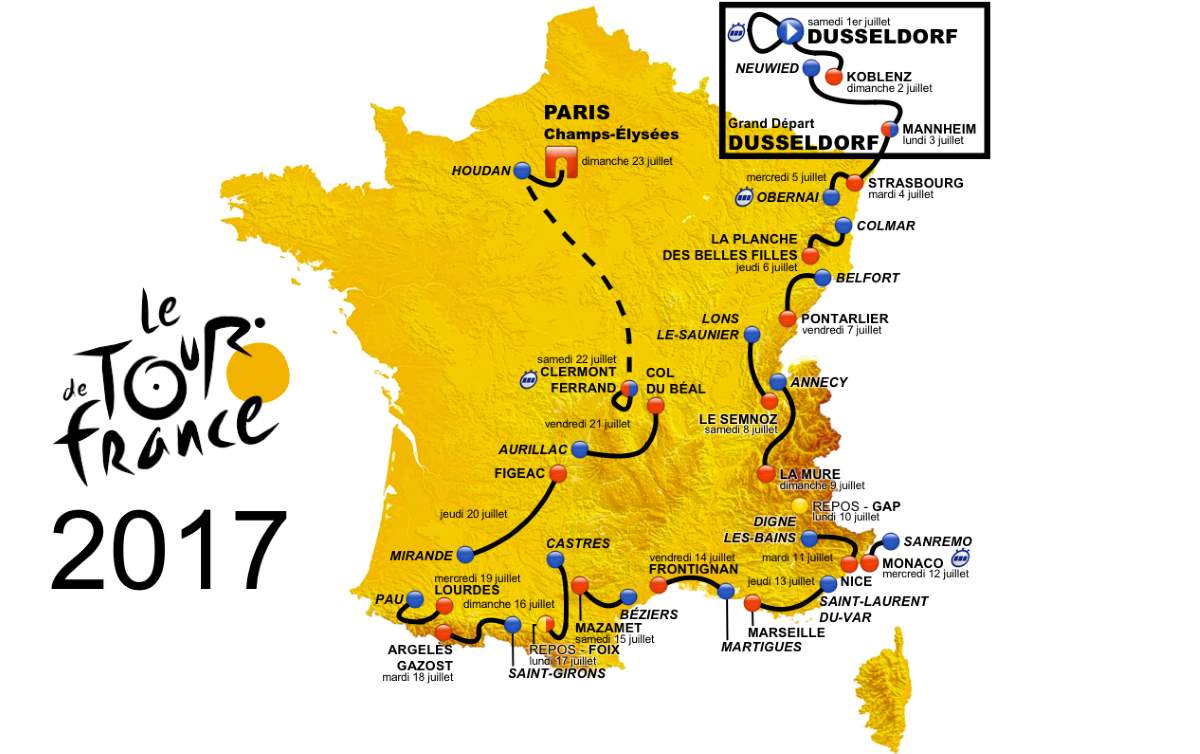
The 104th edition began in Düsseldorf, Germany, continuing the trend of international starts.
It featured punchy stages in the Jura and Pyrenees, and finished on 23 July in Paris with Chris Froome taking his fourth and final yellow jersey.
2016 – Route of the 103rd edition

The race passed through the Massif Central, the Pyrenees, and the Alps, before concluding in Paris.
2015 – Route of the 102nd edition
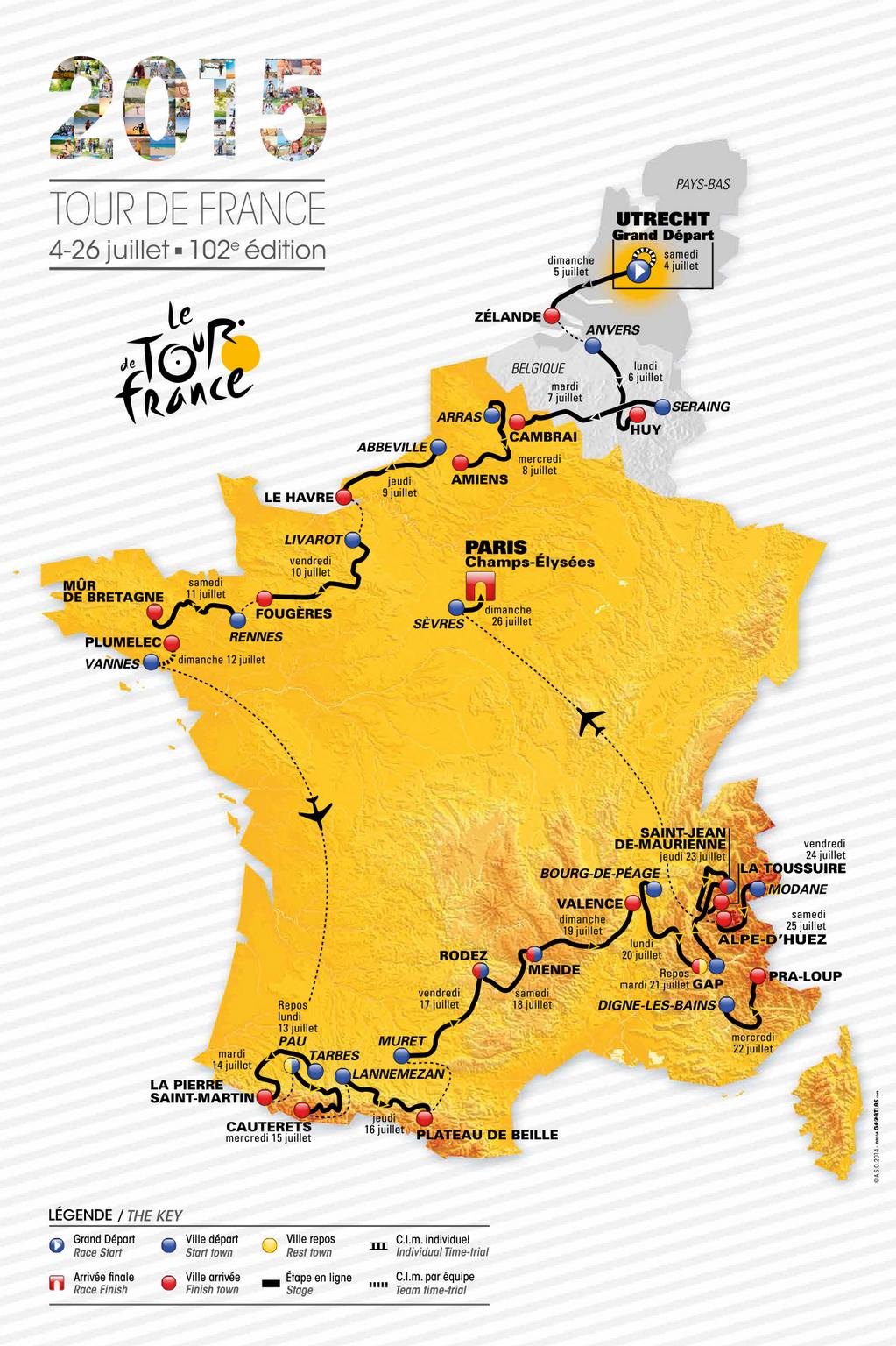
The 102nd edition began in Utrecht, Netherlands, the sixth time the Tour had started in the country.
Riders faced flat stages in Belgium and northern France, before heading into the Pyrenees, southern France, and finally the Alps.
The final stage from Sèvres to Paris crowned Chris Froome as the winner.
2014 – Route of the 101st edition
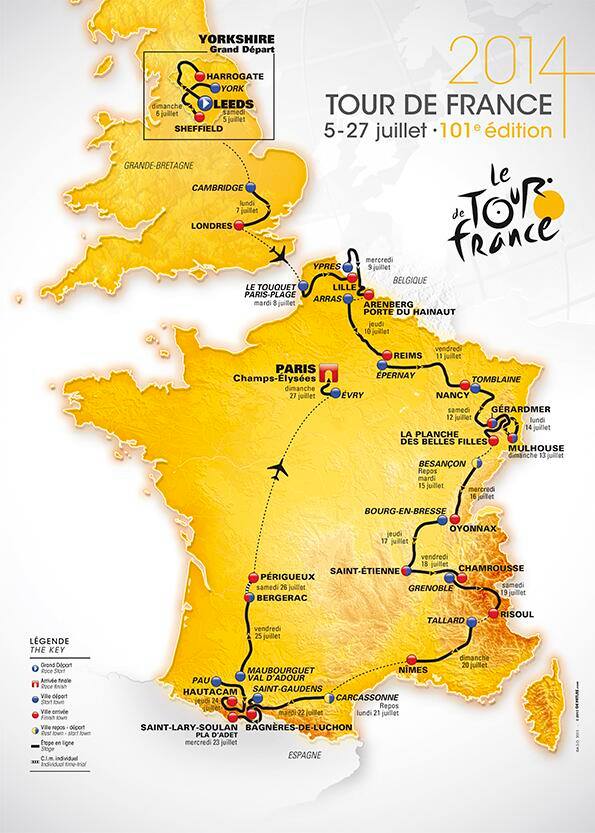
The 101st Tour started in Leeds, England, with stages passing through Harrogate, Sheffield, and London, before crossing into France.
The route commemorated WWI, passing through Ypres, Picardy, and Lorraine, and included historic sites like Strasbourg and Mulhouse.
A milestone event during the final stage was “La Course by Le Tour de France”, a race for elite female cyclists on the Champs-Élysées.
2013 – Route of the 100th edition
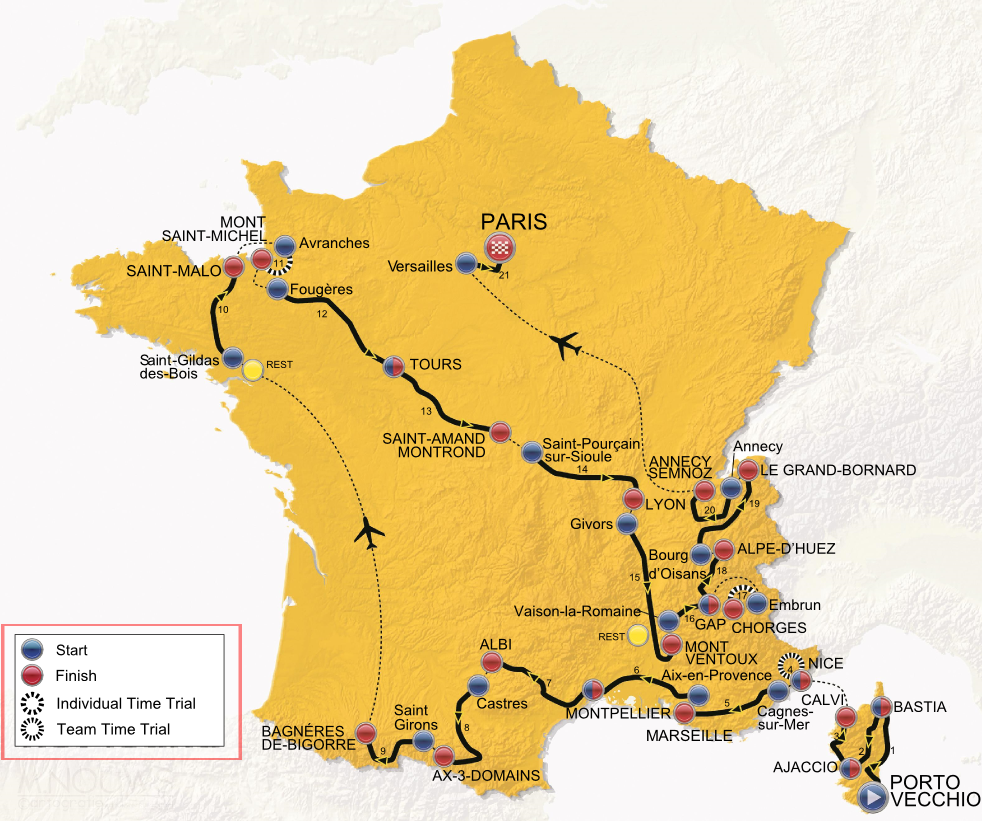
To mark its centenary, the Tour stayed entirely within France for the 100th edition, showcasing national landmarks from Corsica (visited for the first time) to Mont Saint-Michel, Saint-Malo, Alpe d’Huez (with a double ascent), Versailles, and the Loire Valley châteaux.
The race concluded with a nighttime finish on the Champs-Élysées, and Chris Froome claimed his first Tour victory.
2012 – Route of the 99th edition
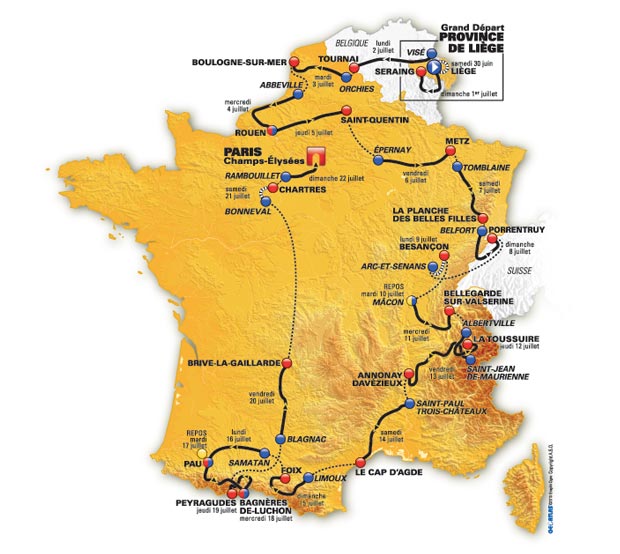
The 99th edition began in Liège, Belgium, and included a detour into Switzerland.
Riders traversed the Vosges, Jura, Alps, and Pyrenees before finishing on 22 July in Paris.
It was a historic moment for Britain, as Bradley Wiggins became the first British rider to win the Tour de France.
The Tour de France in Europe
![Tour de France 2007 in London © Steve F - licence [CC BY-SA 2.0] from Wikimedia Commons](https://frenchmoments.eu/wp-content/uploads/2014/05/Tour-de-France-2007-in-London-©-Steve-F-.jpg-licence-CC-BY-SA-2.0-from-Wikimedia-Commons.jpg)
Since its creation in 1903, the Tour de France has regularly ventured beyond France’s borders.
These international stages not only honour the sport’s global appeal, but also allow new fans to experience the excitement of the race up close.
Grand Départs outside France
- 1954 – Amsterdam 🇳🇱
- 1958 – Brussels 🇧🇪
- 1965 – Cologne 🇩🇪
- 1973 – Scheveningen 🇳🇱
- 1975 – Charleroi 🇧🇪
- 1978 – Leiden 🇳🇱
- 1980 – Frankfurt 🇩🇪
- 1982 – Basel 🇨🇭
- 1987 – West Berlin 🇩🇪
- 1989 – Luxembourg 🇱🇺
- 1992 – San Sebastián 🇪🇸
- 1996 – ’s-Hertogenbosch 🇳🇱
- 1998 – Dublin 🇮🇪
- 2002 – Luxembourg 🇱🇺
- 2004 – Liège 🇧🇪
- 2007 – London 🇬🇧
- 2009 – Monaco 🇲🇨
- 2010 – Rotterdam 🇳🇱
- 2012 – Liège 🇧🇪
- 2014 – Leeds 🇬🇧
- 2015 – Utrecht 🇳🇱
- 2017 – Düsseldorf 🇩🇪
- 2024 – Florence 🇮🇹
These cross-border beginnings offer a fresh dynamic to the race and underscore the international spirit of cycling.
English-French Vocabulary
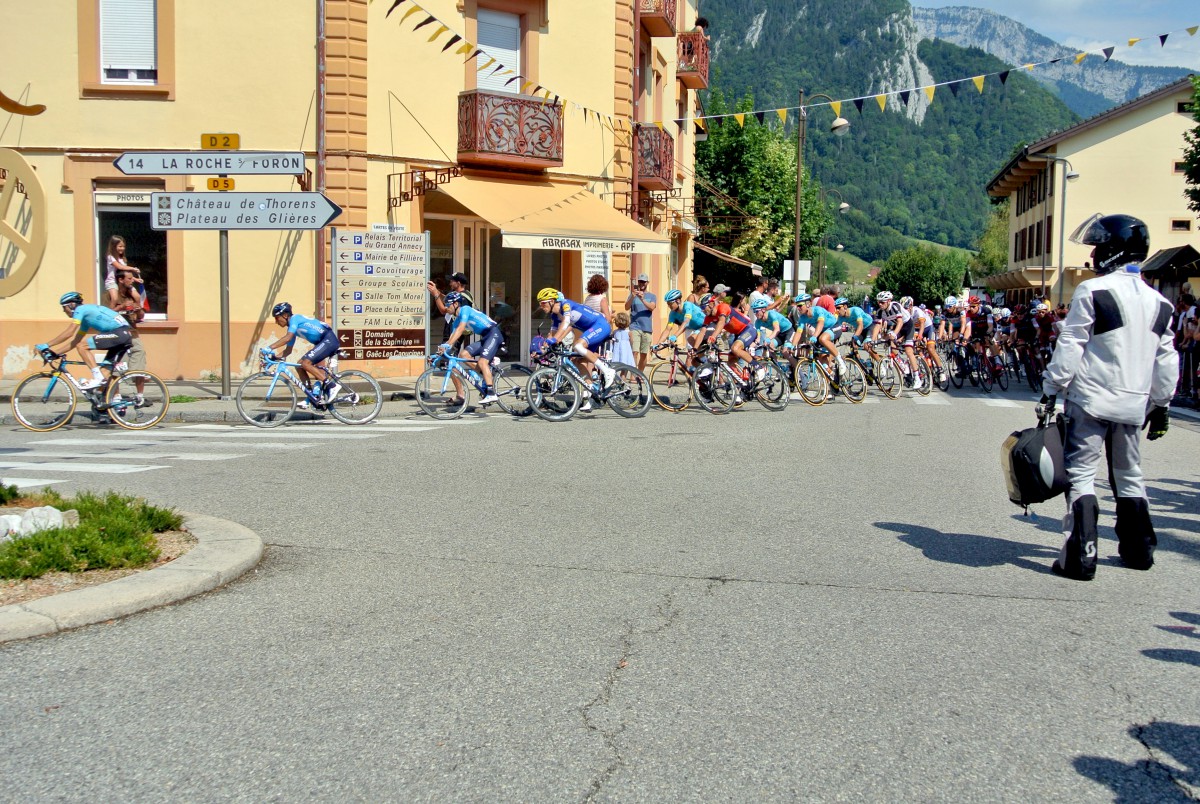
(f) for féminin, (m) for masculin, (adj) for adjective and (v) for verbs
- advertising caravan = caravane publicitaire (f)
- against the clock = contre la montre (m)
- Alps = Alpes (f,p)
- bicycle = bicyclette (f), vélo (m)
- distance = distance (f)
- finish line = ligne d’arrivée (f)
- green jersey = maillot vert (m)
- individual time trial = contre la montre individuel (m)
- jersey = maillot (m)
- mountain = montagne (f)
- pass = col (m)
- podium = podium (m)
- polka-dot jersey = maillot à pois rouges (m)
- Pyrenees = Pyrénées (f,p)
- race = course (f)
- rider = coureur (m)
- road = route (f)
- route = route (f)
- sport = sport (m)
- stage = étape (f)
- start = départ (m)
- team time trial = contre la montre par équipe (m)
- white jersey = maillot blanc (m)
- winner = vainqueur (m)
- yellow jersey = maillot jaune (m)

